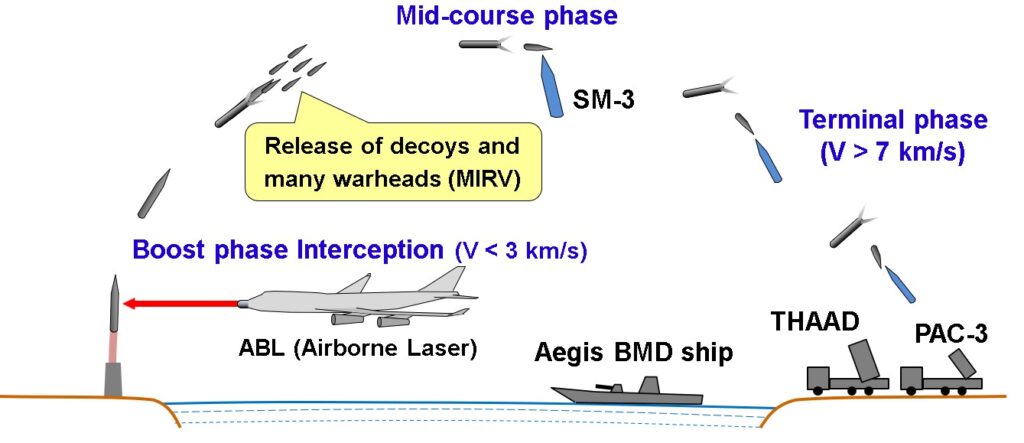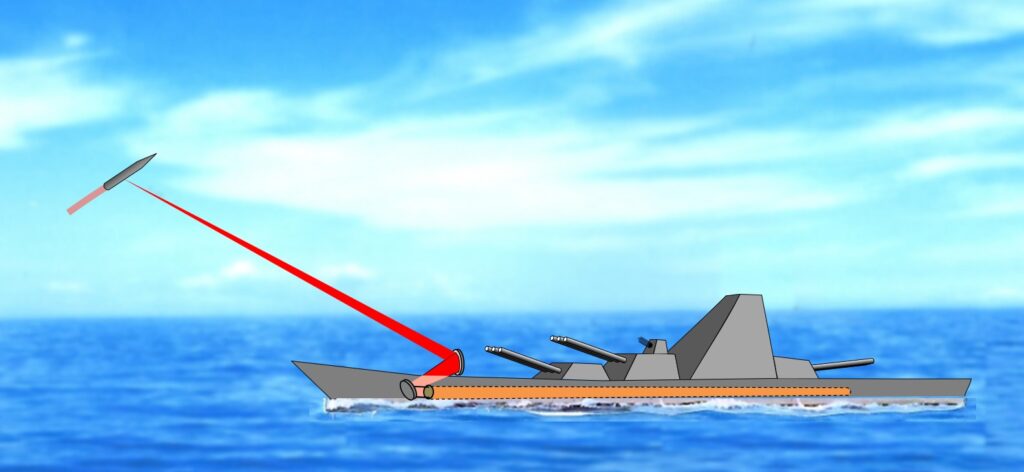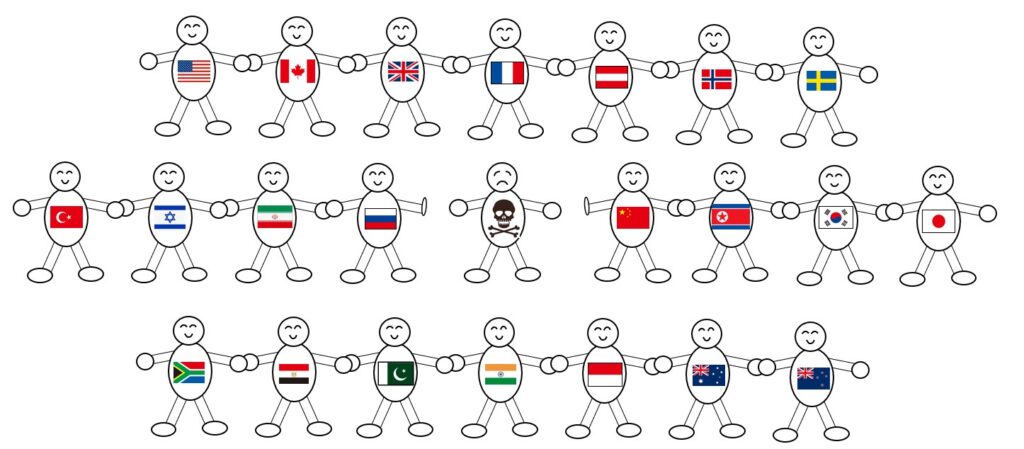投稿者: k.takehisa
Conventional schemes for the missile defense against nuclear missiles are shown in Fig.1.

Fig. 1. Missile defense systems against nuclear missiles.
Although, nuclear missiles in the mid-course phase and/or the terminal phase are the target, the boost-phase interception (BPI) is the best way to shoot down the missiles because their speed is low and it is before releasing the warheads. However, considering the long distance, the BPI can only be achieved by a high-energy laser (HEL) with the speed of light.
Conventionally, such HEL is based on a high-power continuous-wave (CW) laser 1). To intercept a missile, a CW laser beam needs to irradiate the housing of the missile for seconds until it is shot down. However, the targeting technology to irradiate the focused beam at a fixed position on the housing of the fast-moving missile is not easy. Especially if the focused spot is small, in spite of getting a higher laser intensity. Moreover, shooting down a rolling missile by a CW laser is almost impossible. Therefore, we propose to use a pulsed HEL to shoot down a missile (Fig. 2).

Fig. 2. Nuclear missile destruction by a pulsed HEL.
There is another advantage to use a pulsed HEL. Basically, a laser weapon can be useful when the sky is clear. In a rainy or foggy weather, it is not useful. Needless to say, enemy’s missiles can come at any weather. Therefore, the technology of clearing the sky by another high-power laser is important 2) unless the HEL is based on space 3) or in high-altitude air 4). A high-power laser is used to evaporate the rain or the fog to make a clear beam path for the HEL. However, the total volume for the evaporation can be quite large in a windy condition. The required volume is proportional to the product of the wind speed and the laser irradiation time. For a pulsed HEL, the volume becomes the smallest.
We consider the following pulsed chemical lasers have a high potential to shoot down the nuclear missiles.
- Chemical oxygen-iodine laser (COIL) 5-7).
- Chemical oxygen laser (COL) 8-11).
Although, chemical lasers are not easy to use due to the handling of hazardous chemicals, they can operate without a large electric power supply. There is no limit in the output energy by simply preparing a large amount of chemicals and generating an instant chemical reaction.
When such pulsed HEL will be developed, a highly effective missile defense system is realized. Consequently, possessing nuclear missiles is just a huge waste of money considering the cost of >1000 million dollars for a single missile. The shot cost of the HEL, on the other hand, is only ~100 dollars.
References
- Steven Lamberson, et. al., “The airborne laser,” Proc. of SPIE Vol. 6346, 63461M (2007).
- Vladimir B. Krapchev, “Atmospheric thermal blooming and beam clearing by aerosol vaporization,” Proc. of SPIE Vol. 1221, 91-105 (1990).
- Jim F. Riker, “An Overview of the Space-Based Laser (SBL) Program,” Proc. of SPIE Vol. 4632, 181-186 (2002).
- K. Takehisa, “New defence system using a chemical oxygen-iodine laser in a high-altitude airship,” Proc. of SPIE Vol. 10798, 1079803 (2018).
- N. N. Yuryshev, “Pulsed COIL review,” Proc. of SPIE Vol. 1980, 181-185 (1992).
- Kenji Suzuki, et. al., “High pressure pulsed COIL assisted with an instantaneous production of atomic iodine,” Proc. of SPIE Vol. 4184, 124-127 (2001).
- K. Takehisa, “Consideration of a ship defense with a pulsed COIL,” Proc. of SPIE Vol. 9650, 965003 (2015).
- R. L. Kerber, et. al., “Possible high energy laser at 1.27μm,” Applied Optics, Vol. 17, No. 20, 3276-3283 (1978).
- M. Endo, et. al., “Chemically Pumped O2(a-X) Laser,” Applied Physics B, Vol. 56, 71-78 (1993).
- K. Takehisa, “New concepts of realizing a chemical oxygen laser,” Proc. of SPIE Vol. 9251, 92510X (2014).
- K. Takehisa, “Proposal of a defense application for a chemical oxygen laser,” Proc. of SPIE Vol. 9466, 94660W (2015).
Introduction
There has been growing concerns about the use of nuclear weapons in spite of the Treaty on the Prohibition of Nuclear Weapons (TPNW), which is considered as a great millstone for the abolition of nuclear weapons, came into effect in 2021. Although, many peace groups are appealing for the horror of nuclear weapons, many people are beginning to consider that possessing such horrible weapons can avoid being invaded. Unfortunately, TPNW has a difficulty to realize the total abolition of nuclear weapons since nuclear-weapon states seem never to ratify TPNW. This is probably because any nuclear-weapon state cannot abandon nuclear weapons as long as its enemy state is possessing nuclear weapons.
Therefore, a new multilateral treaty is proposed. It prescribes sanctions against a state which actually uses nuclear weapons in a war. As many states support the idea of TPNW, nuclear weapons should never be used. Therefore, if a state actually uses nuclear weapons, the state should be imposed sanctions. Conventionally, the sanctions are discussed and decided afterward in an Emergency Special Session of the United Nations General Assembly. However, since there should not be no sanctions to the state, some sanctions can be prescribed beforehand. Predetermining extremely severe sanctions can make nuclear-weapon states to consider that using nuclear weapons is quite difficult.
Proposed articles for the new treaty
Since it is difficult to impose a military punishment to a state which possess nuclear weapons, the treaty consists of the following three articles as the sanctions.
- Each state shall stop every trade between the state which uses nuclear weapons, except foods for the citizens if necessary. This is in effect for more than 20 years.
- Each state shall prohibit the entry of every people from the state which uses nuclear weapons, except for political exiles. This is in effect for more than 10 years.
- If a state breaks the article 1 or 2, all the other states shall stop every trade between the state. This is in effect for 3 years.
The proposed treaty does not target any nuclear-weapon state. It does not care about the possessing, the production, and the experiment of nuclear weapons. Therefore, any nuclear-weapon state can ratify the treaty, which is different from TPNW. A member state should just impose the sanctions on a state which actually uses nuclear weapons even if the nuclear-weapon attacked state is a potential enemy to the member state.
The reason for adding the article 3 is to eliminate resistance to impose the sanctions. If a state which uses nuclear weapons is a major resource exporter, some member state may hesitate to impose the sanctions without penalty.
Concerning a retaliatory nuclear attack
The sanctions should also be imposed to a state which makes a retaliatory nuclear attack in response to being nuclear attacked. The reason is that a claim of being nuclear attacked may be a clever fake in order to make a nuclear attack. Also, the escalation of the retaliatory nuclear attacks must never be tolerated.
However, in return for enduring the retaliation, the following article should be added.
4. Each state shall provide every-possible rescue and assistance to a member state which is nuclear attacked.
This is similar to the article 6 of TPNW. Even if a nuclear attacked state is a potential enemy, every member state should give the rescue and the support.
The idea of banning the retaliatory nuclear attack may not be supported by nuclear-weapon states. However, if a nuclear attacked nuclear-weapon state really want to make a retaliatory nuclear attack, the state can do so regardless of facing the sanctions. Actually, if the number of member states is small, the sanctions are not severe.
What can be expected
If more than 150 states become the member in the future, even if it takes 100 years, the sanctions become quite effective. Then, there is almost no risk of being nuclear attacked. Therefore, a nuclear-weapon state can be the member without abandoning nuclear weapons until the sanctions become effective.
If a member state is importing large amount of resources from a state which uses nuclear weapons, the member state may suffer a shortage of them. Therefore, all the member states should need to import resources from non-nuclear weapon states with a priority over nuclear-weapon states. Consequently, nuclear-weapon states will need to abolish nuclear weapons in order not to decrease the export.
The proposals presented above may be subject to revision by the discussions with people who wish to abolish nuclear weapons.

If you have a message, please send an e-mail to:
